
YOGA FOR ARTHRITIS
Book Specification
| Item Code: | IDF120 |
| Author: | Dr R Nagarathana,Dr H R Nagendra |
| Publisher: | SWAMI VIVEKANANDA YOGA PRAKASHANA |
| Language: | English |
| Edition: | 2019 |
| Pages: | 114 (B & W Illus: 102) |
| Cover: | Paperback |
| Other Details | 8.5 |
| Weight | 130 gm |
Book Description
It is a common experience of human beings that their minds and bodies are closely interlinked. Any disturbance in either of them is bound to affect the other. Mental worries do lead to physiological problems and bodily discomfort does impact on the mind. Yoga and Ayurveda, the ancient Indian sciences recognised this symbiotic relationship of body and mind long ago and postulated the concepts of Adhi and Vyadhi.
Closely linked with Ayurveda is the science of Raja Yoga and its branch Hatha Yoga. Western philosophy and psychology even now lay great stress on the body and consider the mind to be its by-product. However the ancient Indian sciences have always considered mind as being supreme over matter and have based their practices on this idea.
That yoga practices can help in the amelioration of certain types of psychosomatic diseases has been known for a long time. But no systematic investigation had been undertaken based on modem accepted norms of scientific research. It goes to the credit of Swami Vivekananda Yoga Anusandhana Samsthana (s VY ASA) that over the last quarter of a century it has conducted systematic research in this field and has developed packages of physical and mental practices suitable for several psychosomatic diseases.
There has been a need felt for some time to consolidate these results and to bring them out in the form of booklets, each one dedicated to a particular disease. I am glad that this need has now been amply met by this series of booklets, in which there is a methodical description of the Asanas, Pranayama, Meditation and Kriya, in a simple and easily understandable language and profusely illustrated.
The authors have to be congratulated for the pains they have taken in this venture. The general public indeed has to be grateful to them for the great service they have rendered. I am confident that with the awareness of the benefits of yoga now increasing among people around the world, the discerning persons would make proper use of these booklets for the improvement and maintenance of their physical and mental health.
It was 1977-78 when Eknathji Ranade, the founder of Vivekananda Kendra movement called us and asked "as medical professionals of this motherland, what is your dream?" We said that we could develop several hospitals giving high tech modem medical facilities to the needy brothers of this land. But he said that it is not enough if you just duplicate the hospitals in the existing style. Our mission should be to evolve techniques to unfold the inner potential divinity of man to heal and grow towards better and better positive health. And also establish the efficacy of our ancient science of yoga, which is no less than 5000 years old, in scientific terms as a socially relevant science. He also said that Bharat should have several referal holistic healing centres where people from all over the world would come over and benefit from this unique knowledge of yoga therapy. He was the mastermind who encouraged us to go round the country, study at the feet of Yoga Gurus who had insights into this healing art. It was a great experience to go round several Y ogashrams, talk to patients who had benefited from yoga therapy and record their progress.
It was our main task to learn 'what technique for what disease?' from these masters. After obtaining convincing evidence of the healing potential of the practices that had helped these patients, we sat down to compile the data and prepare the list of practices for different conditions. To our surprise it was all a great mess. The patients had improved very well but it was dynamic asanas in one centre, slow pace of asanas in another, only Pranayama in yet another or only meditation in another. To add to our confusion one guru would use a posture or breathing to cure a condition whereas another guru would prohibit the same posture or breathing for the same condition. For example, if Sarvangasana was never to be practiced for hypertensive patients as per one centre, the same would be the recommended asana in another centre.
A little deeper thinking gave us the clue to decipher this riddle. All these patients using any of the practices had actually practiced 'Yoga' - the state of inner tranquility, mastery and freedom from fears and anxieties. And this was the common factor that helped all of them towards complete recovery. Now it became simple for us to understand Swami Vivekananda's statement that the goal of healing is to unfold the potential divinity by one or more or all of the four aspects of yoga, namely Karma, Bhakti, Jnana or Raja yoga. Thus yoga therapy is not organ specific but it is a science that works holistically to strengthen the inner being.
The next bigger challenge was to put together the concepts learnt from these Gurus, the knowledge base from traditional texts, the growing know ledge of pathophysiology of diseases from modem science and the feasibility of teaching them to our patients in an acceptable and enjoyable fashion.
We started scanning through the traditional texts of yoga and spirituality. The concept of 5 layered existence of all of us as postulated and described in great detail in Taittireya Upanisat as Panca Kosa was found to be the most holistic concept of human existence which is in no way contradicting the modem systematic approach to the understanding of human body. It is more generalised, holistic and hence can contain in it the physical body [Annamaya Kosa] and the next three layers Pranamaya, Manomaya, and Vijnanamaya Kosas which are called the subtle bodies in Vedanta and spiritual lore. The fifth kosa the Anandamaya Kosa is the causal body from where all other layers take birth. Thus we got a holistic and concrete perspective of human existence as the foundation for yoga therapy.
Disease, in modern medical perspective is considered as ,dysfunctioning of organs and systems which may be due to congenital defects, external atmospheric agents like allergens, toxins, pollutants or infectious germs. Modern science does recognize that the other major cause for diseases could be the factor of internal imbalances like mental restlessness, emotional upsurges or intellectual conflicts that lead to stress reactions.
The concept of disease according to yoga is found in the treatise called Yogavasistha. According to this text, the modern diseases such as asthma, diabetes, hypertension, and anxiety are called "Adhija Vyadhi'{stress born diseases) originating in Manomaya Kosa- the astral layer of our existence. They arise from our actions that are governed by our emotions [strong likes and dislikes] rather than what is right or what is wrong. Often in this phase, we respond to our emotions - the pull of senses knowing fully well that we are going against what is right. This is called, Prajnaparadha in Ayurveda-a mistake at the level of inner consciousness. It is this' going against what is right - the cosmic law 'that causes an imbalance, a disease at the Manomaya Kosa called Adhi.
The Adhi at the astral layer if not remedied will bring imbalances at the level of Pranamaya Kosa that shows up as breathing jerks, imbalances and speed. This in turn creates stress reactions causing autonomic and endocrine imbalances leading to diseases in the body called Vyadhi. Such diseases are called Adhija Vyadhi i.e. Vyadhis created of Adhis. The other category of diseases such as infections and injuries come under Anadhija Vyadhis which essentially are physical in nature and can be tackled by modern medical system effectively. Since the Adhija Vyadhis are multi dimensional, we need to tackle them not merely with physical symptomatic treatment measures. The whole man has to be treated. And only then can there be lasting remedy to our problems of the modern era. The answer lies in the Integrated Approach of Yoga Therapy that provides techniques for correcting the problem at both the gross (physical) and subtle levels. Yoga practices help in bringing about balance at the level of all the five Kosas so that complete health can be restored. The practices at Annamaya Kosa include yogasanas, Sithilikarana vyayama [loosening practices], yoga diet and yoga kriyas, at Pranamaya Kosa - breathing practices, breathing kriyas and Pranayama. At the Manomaya Kosa, the practices are meditation [Cyclic meditation and Om meditation], devotional sessions and happy assembly, where-as lectures, counseling and satsangs correct the notions about one's life ambitions and goals that form the basic conceptual root for the life style of the individual. Karma yoga and tuning to nature are the practices that help one to get established in Anandamaya Kosa bringing bliss in our lives.
Based on all these information, we felt confident to start off our courses in yoga therapy with several workshops, camps, conferences, and seminars between 1980 to 85. Thousands of patients participated, learnt the techniques and started giving their feed -back. Based on the experiences of the patients we went on learning what, why and how of many of the techniques taught to them. A general set of integrated approach of yoga therapy which gave fascinating results in diseases like asthma, diabetes, hypertension, anxiety, etc. started evolving into more and more specific practices which could give quicker results, requiring lesser duration of practices. We also learnt from the feedback of patients how to give immediate relieffor episodic conditions like asthma, migraine, panic disorders, etc. While treating these patients, we recorded data before and after 2 weeks of yoga therapy and followed them up to 10 years. The results were statistically analysed and published in indexed scientific medical journals.
This series of booklets include step by step instructions for the set of practices, which could be practiced for an hour daily by patients with different ailments. These are safe practices. The practices that could be harmful for the conditions have been carefully avoided based on the knowledge of the physiological effects of these practices and its expected effects on the disease. However it is safe for you to ask your doctor or medical advisor before you start practising these techniques. The ideal way to use this booklet is to keep this as a reference book after you have learnt them under the guidance of a yoga teacher trained in our system of yoga therapy.
The list of practices mentioned in the contents are all safe. If you have more than one illness, you need to select these common practices from the list for all those illnesses (see our other volumes).
The complete list in the booklet would take more than one and half hour to practice. Start with a set of simple practices amongst these, and gradually go on to achieve the capacity to perform the entire set.
The ideal way to plan your daily yoga practices is, 45 minutes of physical practices followed by Savasana in the morning, Pranayama and meditation for 45 minutes in the evening. Daily practice is mandatory. Physical practices have to be performed only in empty stomach or 4 hours after a major meal or 2 hours after a small meal. Do not practice yogasanas when you are very tired or during menstruation. Meditation and Nadanusandhana can be practised even after a meal or during menstruation in women.
We are indebted to Smt. Subhadra Devi, Kum. Asha Didi, Sri Ganga Ningombam, Sri. Natesh and many other Yoga Therapists for their help in preparing this booklet.
| Page Nos. | ||
| 1 | MODERN MEDICAL AND YOGA PERSPECTIVE OF ARTHRITIS | 1 |
| 2 | SITHILIKARANA VYAYAMA AND YOGASANS. | 31 |
| A | Sthiti (initial) and Sithila (relaxation) Protures for all Sithilikarana Vyayama and Asanas. | 31 |
| B | Sithilikarana Vyayama (Loosening Exercise) | 35 |
| 1. Passive rotation of toes | 35 | |
| 2. Toe Bending | 35 | |
| 3. Ankle Bending | 36 | |
| 4. Ankle Rotation | 37 | |
| 5. Knee Bending | 38 | |
| 6. Knee Rotation | 38 | |
| 7. Knee Cap tightening | 39 | |
| 8. Half Butterfly | 39 | |
| 9. Full Butterfly | 40 | |
| 10. Waist Rotation | 42 | |
| 11. Wrist Rotation | 42 | |
| 12. Shoulder Rotation | 43 | |
| 13. Neck Bending | 44 | |
| 14. Neck Rotation | 46 | |
| C | Sakti Vikasaka Suksma Vyayama | 47 |
| 1. For Wrist - Mani Bandha Sakti Vikasaka | 47 | |
| 2. For Palms - Kara Tala Sakti Vikasaka | 47 | |
| 3. For Fingers - Anguli Sakti Vikasaka | 48 | |
| 4. For Elbows - Khaponi Sakti Vikasaka | 48 | |
| 5. For Arms - Bhuja Bandha Sakti Vikasaka | 49 | |
| 6. For Back - Kati Sakti Vikasaka | 49 | |
| 7. For Thighs - Jangha Sakti Vikasaka | 50 | |
| 8. For Calf Muscles - Pindali Sakti Vikasaka | 51 | |
| D | YOGASANAS | 52 |
| 1. Ardhakati Cakrasana | 52 | |
| 2. Ardha Cakrasana | 53 | |
| 3. Pada Hastasana | 53 | |
| 4. Bhujangasana | 54 | |
| 5. Salabhasana | 55 | |
| 6. Dhangurasana | 55 | |
| 7. Sarvangasana | 56 | |
| 8. Matsyasana | 57 | |
| 9. Viparita karani | 58 | |
| 10. Halasana | 58 | |
| 11. Cakrasana | 59 | |
| 12. Sasanjkasana | 60 | |
| 13. Vakrasana | 61 | |
| 14. Ardha Matsyendrasana | 61 | |
| 15. Ustrasana | 62 | |
| 16. Instant Relaxation Technique (IRT) | 63 | |
| 17. Quick Relaxation Technique (QRT) | 64 | |
| 18. Deep Relaxation Technique (DRT) | 64 | |
| 3 | PRANAYAMA | 67 |
| A. | Postures for Pranayama and Meditation | 67 |
| B. | Mudras for Pranayama and Meditation | 69 |
| C. | Preparatory Practices for Pranayama | 71 |
| 1. Cleansing Breath (Kapalabhati Kriya) | 71 | |
| 2. Vibhagiya Svasana | 73 | |
| D. | Pranayama | 77 |
| 1. Surya Anuloma Viloma Pranayama | 77 | |
| 2. Candra Anuloma Viloma Pranayama | 77 | |
| 3. Nadisuddhi Pranayama | 78 | |
| 4. Cooling Pranayama | 79 | |
| 5. Bhramari Pranayama | 81 | |
| 4. | MEDITATION | 83 |
| 1. Nadanusandhana | 83 | |
| 2. OM Dhyana (Meditation) | 85 | |
| 5. | KRIYAS | 87 |
| 1. Jala Neti | 87 | |
| 2. Sutra Neit | 88 | |
| 3. Vaman Dhouti | 88 | |
| 6. | INTEGRATED YOGA MODULE FOR ARTHRITIS | 90 |
| ONE HOUR SCHEDULES - Set-A | 96 | |
| ONE HOUR SCHEDULES - Set-B | 98 | |
| INDEX | 100 |
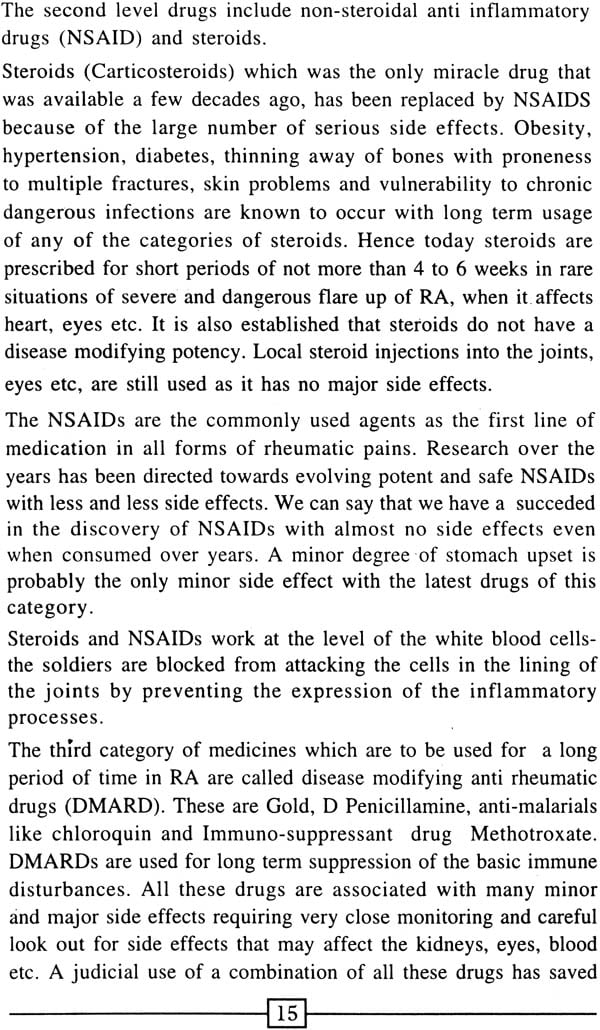
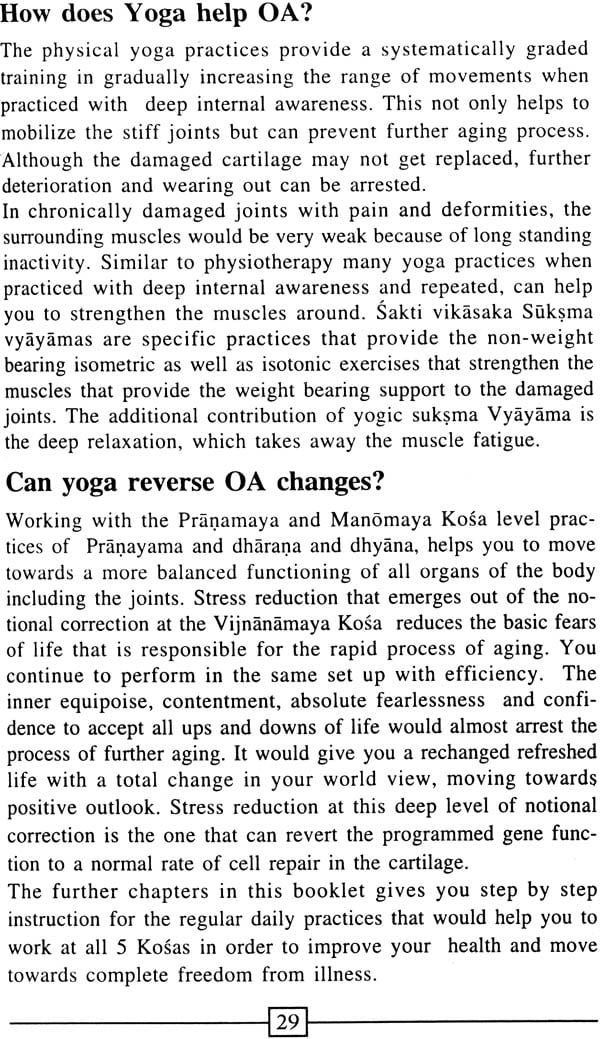
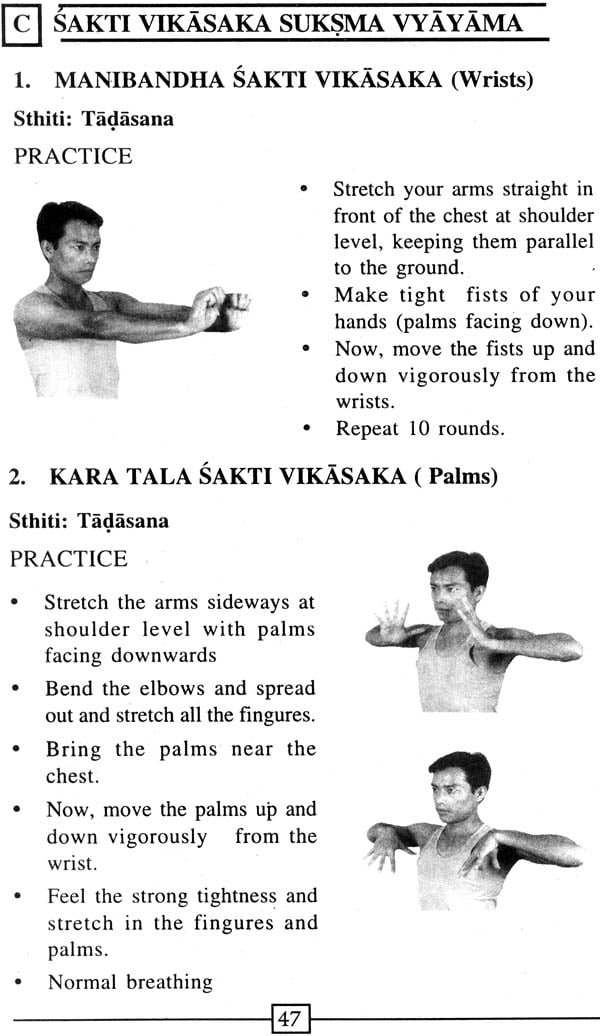
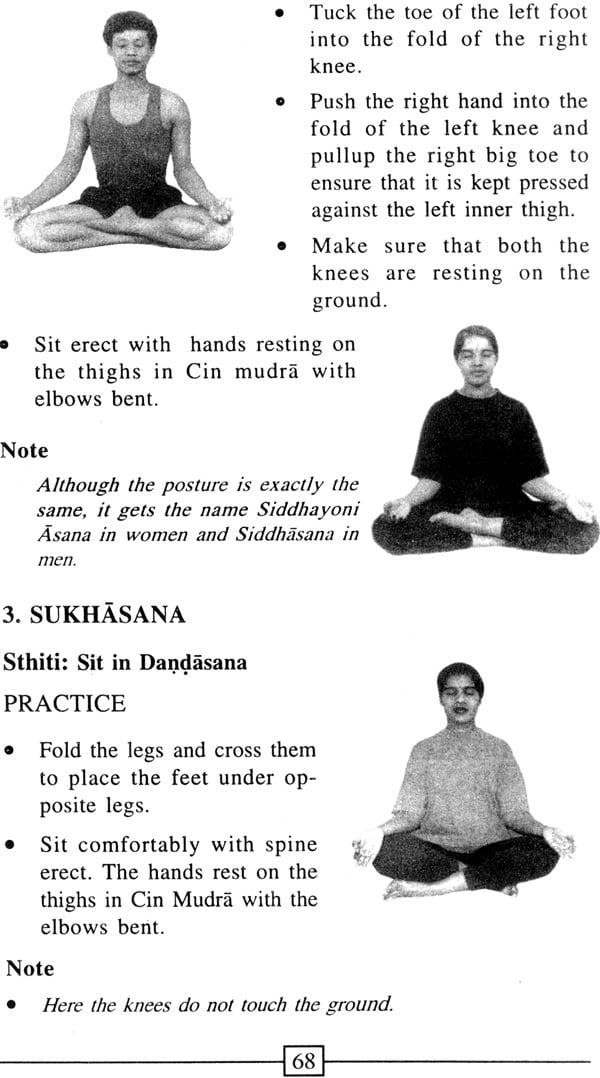
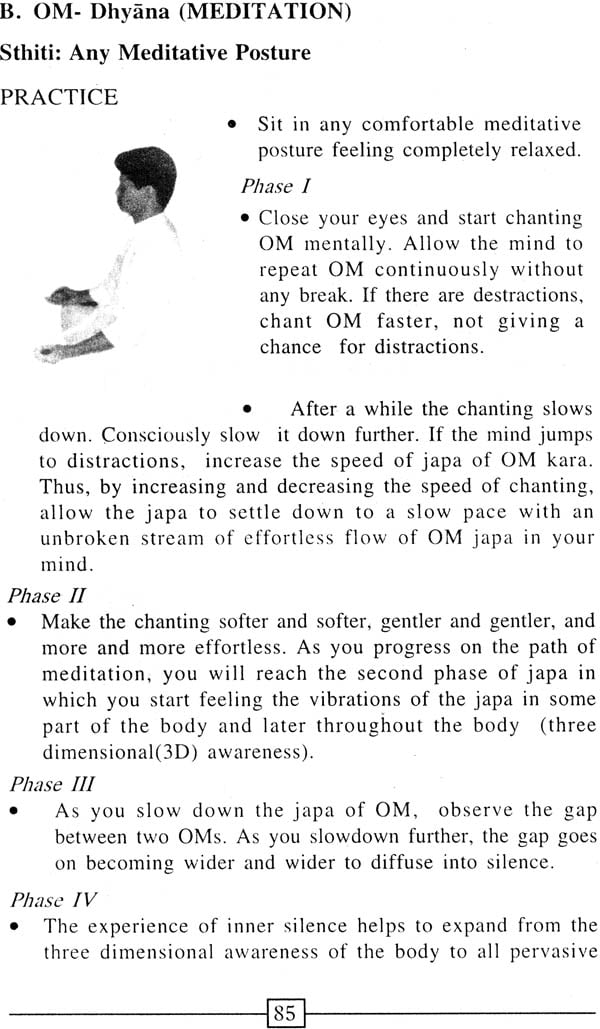
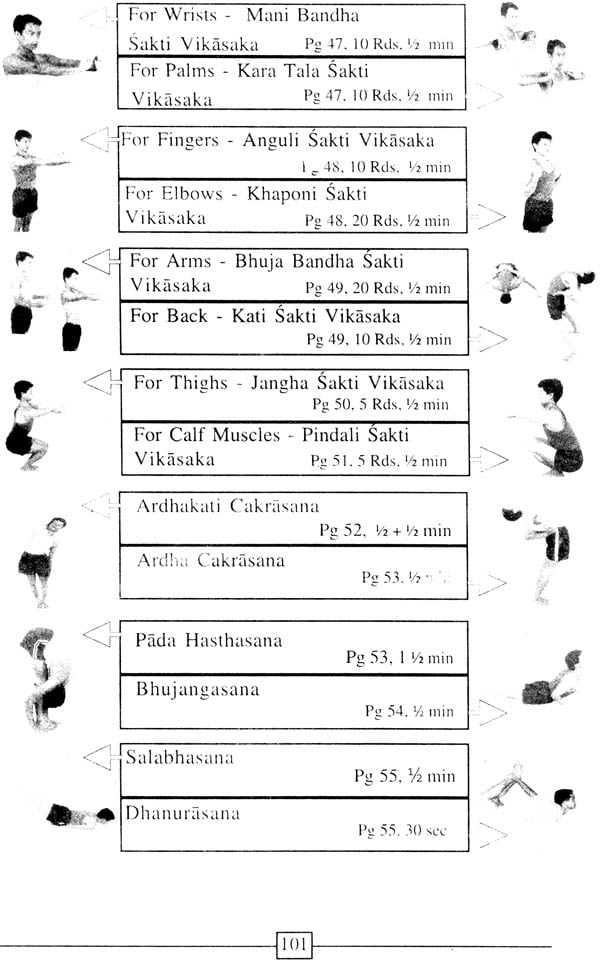
Click Here for More Books Published By Swami Vivekananda Yoga Publications





